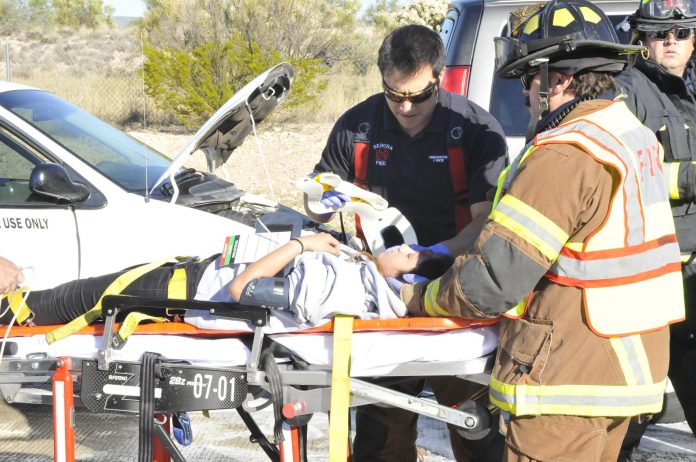Drivers passing by the McGuireville rest area off Interstate 17 on the morning of Nov. 8 were subject to a rare sight: A motor vehicle accident training drill involving five dozen personnel from nine different public safety departments.
An interagency memo on Nov. 7 documented the plan set to begin after 8 a.m.
“The training will consist of a motor vehicle accident involving a 12-passenger van being involved in a rear-end type collision with a passenger vehicle.
The van has sustained heavy damage and has multiple patients ….
The passenger vehicle has sustained heavy damage and has an apparent fuel leak coming from the engine compartment.”
“Such events are known as Multiple Casualty Incidents, and by definition, exceed the ability of local resources to manage them, and thus require additional support from surrounding agencies,” Copper Canyon Fire and Medical Authority Fire Chief Terry Keller said.
Keller operated as the lead organizer of the drill, directing approximately 60 crew and volunteers — including 15 “patients” — from CCFMA, Sedona Fire District, Verde Valley Fire District, Verde Valley Ambulance, Guardian Medical Transport, Cottonwood Public Safety Communications Center, Honor Health Deer Valley, Arizona Department of Public Safety and the Arizona Department of Transportation.
ADOT secured the rest area throughout the drill, closing off access to the facilities and directing traffic.
“Once on scene, the initial crews mitigated a small fire, they triaged the injured from most to least injured, provided treatment and then simulated transportation to medical helicopters and local hospitals,” Keller said.
At this point, crews traveled to the Rimrock Airport, greeting a Guardian Air helicopter.
Together, personnel reviewed the safe operating procedures necessary to guarantee maximum safety for the injured.
“Most involved commented that the drill was a success, and that continued efforts for more cooperative training such as this needs to be pursued,” Keller said.
For all its value, Keller later said that the public’s reaction to training drills can be negative.
“When we encounter the public, they are often our patients and they appreciate our assistance,” Keller said.
“However, on incidents such as this, often the motoring traffic is put out because we have to halt traffic to operate safely …. We are trying to help those who need help, and so minor delays are required to ensure that help can be safely rendered.”



